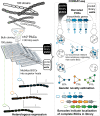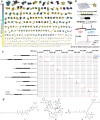Multiplexed mobilization and expression of biosynthetic gene clusters
- PMID: 36068239
- PMCID: PMC9448795
- DOI: 10.1038/s41467-022-32858-0
Multiplexed mobilization and expression of biosynthetic gene clusters
Abstract
Bacterial genomes contain large reservoirs of biosynthetic gene clusters (BGCs) that are predicted to encode unexplored natural products. Heterologous expression of previously unstudied BGCs should facilitate the discovery of additional therapeutically relevant bioactive molecules from bacterial culture collections, but the large-scale manipulation of BGCs remains cumbersome. Here, we describe a method to parallelize the identification, mobilization and heterologous expression of BGCs. Our solution simultaneously captures large numbers of BGCs by cloning the genomes of a strain collection in a large-insert library and uses the CONKAT-seq (co-occurrence network analysis of targeted sequences) sequencing pipeline to efficiently localize clones carrying intact BGCs which represent candidates for heterologous expression. Our discovery of several natural products, including an antibiotic that is active against multi-drug resistant Staphylococcus aureus, demonstrates the potential of leveraging economies of scale with this approach to systematically interrogate cryptic BGCs contained in strain collections.
© 2022. The Author(s).
Conflict of interest statement
S.F.B. consulted for Zymergen. The remaining authors declare no competing interests.
Figures


References
Publication types
MeSH terms
Substances
Grants and funding
LinkOut - more resources
Full Text Sources
Other Literature Sources
Medical

